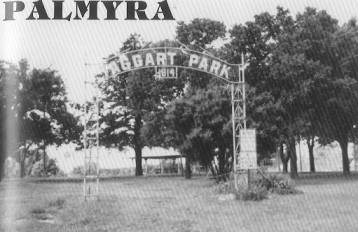
On gently rolling hills near the Little Nemaha Creek, our town was platted in 1870 on land belonging to Rev. John M. Taggart, a Baptist minister. Taggart, who arrived early in 1856, was also an architect, stone cutter, and served in the territorial legislature. Early activities included a Sabbath school, "...held in an old log schoolhouse in 1856, Rev. Webb officiating." As pioneers settled along the cut-off trail from Nebraska City to Fort Kearny, a post office was requested. Established on June 20, 1862, it took its name from the ancient city of Palmyra in Asia Minor. Prior to this, mail was brought to J. R. McKee's farm by the stagecoach. McKee's great-granddaughter, Barbara Fey, served ten years as Palmyra's postmaster, retiring in 1989 after 30 years of postal service. A "real town" started to take shape when the Midland Pacific Railway was being built parallel to the old trail in 1870-71. When platted, a four-square-block village park was dedicated and named Taggart Park in his honor. Oakley's built a general store, Sylvanus Brown established a hardware store, which included a stock of agricultural implements, and Foster & Garnett also erected a store. Viola Campbell built the first home in the spring of 1870, at which time the post office was moved to her home and run by her daughter. When the first train arrived in April 1871, Palmyra was well established. In 1873, with the help of local farmers and citizens -- each subscribing $1,500 toward construction -- Gualt & Powell built a mill. The following year, using a windmill for power, a machine shop and elevator was established. A larger schoolhouse was also built in 1874 at a cost of $3,300. Palmyra's first library, located in the town hall basement, was destroyed by fire on December 24, 1913. Moved to space above the drug store, it was again burned (along with many other buildings) in 1914. The Woman's Club decided that a fire-proof library should be built, a structure which is still being used. For many years, Palmyra's premier event was a day-long picnic. First suggested by settler Edwin Baldwin in 1870 "...to welcome the many new settlers to the area," it was formally organized in 1887 as the Old Settlers' Association. Held at J. R. McKee's grove just south of town until 1899, the gathering grew of over 10,000 persons, many of whom arrived on special trains that offered reduced rates for the event. It was moved to the village park, where a big tent could shelter people from the sun. There were bands, races, contests, and "...plenty of food, music, and political speakers." A "big affair" was featured at the 1933 picnic, when a monument was dedicated on the Douglas Road south of town, marking the early westward trail from Nebraska City to Denver. Built from stones gathered from the foundation of the Oakley store, a bronze plaque commemorates "...the second night stop" along that trail. For the 100th anniversary of the event, observed June 13-14, 1987, Palmyra's senior citizen, 96-year-old Dick Nash, was chosen Grand Marshal of the "Parade of the Century." Other excitement in bygone days was provided by baseball games and horse races. It is said that Palmyra had two real-good race tracks. Today over 500 people call Palmyra home. A housing development, started in the 1970s, provided for new growth. Our businesses include a grocery store, a bank, a farmers' co-op, numerous small shops, and gas stations. The school district, which consolidated with Bennet in 1869, remodeled its facilities in 1982. The Senior Citizens' Activities Center, built in 1984, attracts senior diners daily and is available for other activities in the evening. Volunteers provide fire protection for the town and rural residents, and have formed a quick-response medical squad. Volunteers also support year-round athletic programs that ranges from kid's T-Ball to adult co-ed volleyball. Others deliver meals-on-wheels, care for plants around town, publish a monthly village newsletter, and provide fun and educational programs for all ages. These are the things that help make our town, Palmyra, a nice place to live and grow. By Bob Fey, Box 194, Palmyra, NE 68418, with the help of his daughter Pam Bolz (a great-great granddaughter of J. R. McKee, one of the original settlers of Palmyra). ADDITIONAL MATERIAL: "Picnic Day" by Winifred Dowding, 1987; and an earlier history by Cora Nash and J. H. Sweet. |
| Home | Contact |
© NEGenWeb
